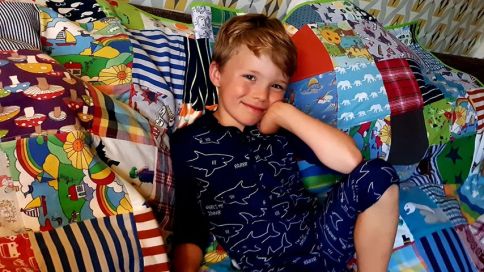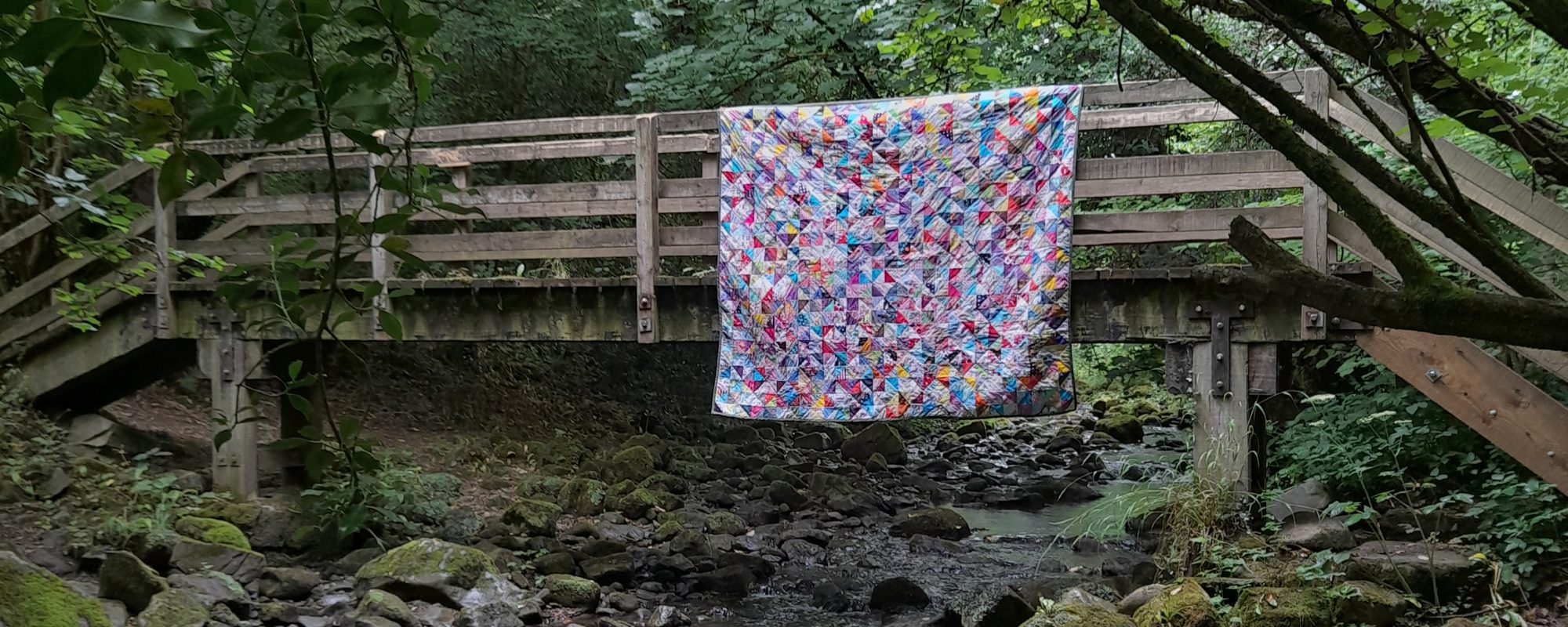
I first learnt to cut and stitch patchwork sitting on the living room floor of family friend Barbara Thompson. Walking into her house, there was always the aroma of cooking spices, books, wool. The walls were covered in bookshelves, almost as though her house was built with stories, not bricks, and the books that didn’t fit on shelves sat in towering piles around her chair. Barbara’s chair was a high backed, old fashioned wing armchair, stuffed with cushions, and surrounded by crafting projects, yarn, bags of fibre, pots of knitting needles, crochet hooks and a pair of scissors for every job imaginable.. The sofa was covered
My first patchwork quilt began in her sitting room, from hand cut hexagons that she showed me how to piece together, one, then another, until I had a lap full of flower shapes, ready to stitch to each other. A myriad of colours, like a blanket made of rainbows. There was something about sewing scraps of fabric together to make a whole piece of cloth that sparked a light in me that has never yet blown out. I painstakingly hand stitched those multi coloured hexagons into a long enough length of patchwork to make a full length skirt for my best friend’s 18th birthday. It was a fancy dress party, and I went as Cinders in rags.

When the party was over, the skirt, in the absence of a proper case, wrapped my steel strung acoustic guitar to protect it as I traveled to and from University. Eventually, it became a quilt – hand quilted, hand embroidered, batted with old sheets. It’s been 28 years since I finished it, and it has since wrapped both my babies and adorned the back of every sofa I’ve ever owned. Of course, it has now been joined by many more quilts, that layer up our beds in the cold winter evenings, and sit in piles next to the sofa, ready to be snuggled under when the draft from the back bay window becomes too chilly. My direction in quilting nods to my ancestors, who so often made their quilts from old clothes, creating new, colourful tops to lay over old, worn quilts. I have a wholecloth quilt that is especially warm, and which was stitched by some long ago ancestor on my mother’s side – the stitches tiny and neat, perhaps telling a story of the character of the woman who sewed them. It has the weight of a quilt that has other quilts inside it, but I have never yet felt able to unpick her stitches, and undo her work to find out. Some things are better left to quiet honour.

Quilting has become a huge part of our livelihood this last year, and I am constantly amazed that something I feel so deeply for has become our bread and butter. Sometimes, as I’m crawling on the floor over layers of fabric, pinning and smoothing and hearing my knees groan, it’s not so much fun, but as a process of creating from waste, it could not be more perfect, and I love seeing a whole new piece of patched cloth appearing before me as I stitch. I have spent many hours these last years, cutting and piecing and stitching quilts to cover strangers and friends alike. I am grateful with every stitch I sew, and every patch I cut.
Memory quilt commissions have become increasingly popular, with families turning over to me their precious baby clothes and the clothes of loved ones gone, to be cut up and stitched back together as quilts full of stories.

There’s always an internal struggle with this work – cutting up clothes that are more often than not in beautiful condition really feels challenging, but then they are stitched back up again into a usable, practical blanket, instead of a carrier bag full of too-small-to-fit-anymore clothes scurried away in a dark cupboard or loft. They bring such joy in their new form – being used again, full of stories and memories – that I always find myself able to let go of the difficult feelings, and embrace the beauty of the process. You can read about the first memory quilt I made here, and who I made it for.
It feels so satisfying to be writing about my quilting journey – and I’ve been doing that a lot lately. Last month, I entered a writing competition for the first time in my life. I sat at 3am, while my children slept, and wrote for The Green Parent Magazine about patchwork quilts, and the planet, and my babies, and how huge it would be if we could all make a return to bedding that isn’t made of plastic. It was an off-the-cuff, unplanned and un-spell-checked article that felt so good to write. I sent it off and promptly forgot all about it, but was delighted this week to find out that I won runner up, and had my article published on their website. You can read it here.
We are waking up to the idea that natural fibres in our clothes are generally a good idea – recycled/second hand clothes even better, and that man made, plastic fibres are really not okay. There’s a definite shift to consider the cloth we lay beside our skin in the clothes we choose. We are coming to terms with the human and planetary energy and resources that go into making our clothes. We are slowly, slowly rejecting fast fashion. We are considering repairing and mending clothes and turning our backs on the idea that clothes which are mended have negative social connotations. Yet the place we spend half our lives (if we’re lucky enough to get that much sleep!) gets little thought at all. Polyester, hollow-fibre quilts and pillows and acrylic fleece blankets are standard on our beds today, never mind the contents of our memory foam mattresses.
I’d like to see a return to the older ways of keeping warm at night. Quilts and blankets that can be layered up when it’s cold, or stored away when it’s warm. I’d like to see as much attention given in activism towards bedding as is given to fast fashion. I want to help join the dots in our connection with the energy and resources used to produce the blankets and sheets and duvets we sleep under, with all their health implications, and look for better, sustainable, affordable ways to bring positive change. I’d like to think that the quilts I’m making now will still be in use when I’m gone, and that the skills that Barbara Thompson passed to me will be passed on to my children, and maybe a whole host of other people too. And that together, we can all work together to stitch the stories of our days into blankets that will keep future generations warm at night, without a scrap of plastic in sight.

Join the conversation by using #plasticfreesleep and #thephoenixgreen on your social media platforms.
Buy a handmade patchwork quilt that’s as unique as you, here.
My blog and everything in it will always be free to inspire and support people to live with less plastic, live more sustainably, live with less, and work to reduce the impact of climate change. It does, however, incur running costs. If you are able to contribute to these costs you are welcome to leave a tip in my tip jar here. If you are able to support me monthly, and would like some beautiful handmade creations in exchange, check out my new Patreon site. If, however, in these financially challenging times, you’re not able to do either of these things, please know that sharing the link to this post on your social media platforms is more than enough. Stay well. Thanks and love, Kate.

Love your patchwork , lovely to see you keeping up the traditions of our childhood too, I remember Barbara Thompson well , a truly inspirational and kind lady .
LikeLiked by 1 person
Beautifully evocative piece about the threads that bind you to your amazing craft. Thank you for sharing.
LikeLiked by 1 person
I just love how colorful
They are!
LikeLike